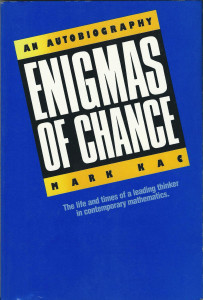 I had the great pleasure to read once again recently the autobiography of Mark Kac (1914 - 1984) entitled Enigmas of chance, published initially in 1985, shortly after the death of the author. Mark Kac, born Marek Kac, is a famous Polish-American mathematician and more precisely a great probabilist and mathematical physicist of the twentieth century. He was born in eastern Europe in a Polish family, and grew up as a young mathematician under the advisory of Hugo Steinhaus (1887 - 1972), a great figure of the Polish school of functional analysis in Lwów at that time. He moved to America after his PhD and became famous. His autobiography gives interesting information about life and research during his time. The description of his quest for the understanding of the notion of stochastic independence with Hugo Steinhaus is truly fascinating. Mark Kac is a remarkable mind, who was most of the time attracted by simple problems and deep solutions. He was in a way a problem solver without being a heavy technician, with a tasty sense of elegance. He was attracted by mathematical physics. Among other things, he produced the rigorous formalization of the notion of phase transition. He is known for many things, including the Ten Martini Problem and Can one hear the shape of a drum? His autobiography contains several anecdotes, like this one about George Uhlenbeck (1900 - 1988):
I had the great pleasure to read once again recently the autobiography of Mark Kac (1914 - 1984) entitled Enigmas of chance, published initially in 1985, shortly after the death of the author. Mark Kac, born Marek Kac, is a famous Polish-American mathematician and more precisely a great probabilist and mathematical physicist of the twentieth century. He was born in eastern Europe in a Polish family, and grew up as a young mathematician under the advisory of Hugo Steinhaus (1887 - 1972), a great figure of the Polish school of functional analysis in Lwów at that time. He moved to America after his PhD and became famous. His autobiography gives interesting information about life and research during his time. The description of his quest for the understanding of the notion of stochastic independence with Hugo Steinhaus is truly fascinating. Mark Kac is a remarkable mind, who was most of the time attracted by simple problems and deep solutions. He was in a way a problem solver without being a heavy technician, with a tasty sense of elegance. He was attracted by mathematical physics. Among other things, he produced the rigorous formalization of the notion of phase transition. He is known for many things, including the Ten Martini Problem and Can one hear the shape of a drum? His autobiography contains several anecdotes, like this one about George Uhlenbeck (1900 - 1988):
Uhlenbeck's attitude to Wiener's work was brutally pragmatic and it is summarized at the end of footnote 9 in his paper (written jointly with Ming Chen Wong) "On the Theory of Brownian Motion II" : the authors are aware of the fact that in the mathematical literature, especially in papers by N. Wiener, J. L Doob, and others [cf. for instance Doob (Annals of Mathematics 43, 351 {1942}) also for further references], the notion of a random (or stochastic) process has been defined in a much more refined way. This allows [us], for instance, to determine in certain cases the probability that the random function y(t) is of bounded variation or continuous or differentiable, etc. However it seems to us that these investigations have not helped in the solution of problems of direct physical interest and we will therefore not try to give an account of them.
In America, Mark Kac worked notably for Cornell University and the Rockfeller University. For my old fellows:
When I went to the Rockfeller in 1961 I was almost forty-seven years old, an age at which one is theoretically way past one's mathematical prime. By and large it is true, for mathematics and, even more, physics are young men's games. And yet some of what I consider to be my best work was done during my years at the Rockfeller when I was by accepted reckoning an old man.
Another interesting autobiography of a great Polish-American mathematician & physicist is the one of Stanislaw Ulam (1909 - 1984) entitled Adventures of a Mathematician. Ulam and Kac belong to the same generation and they knew each other.
Leave a Comment